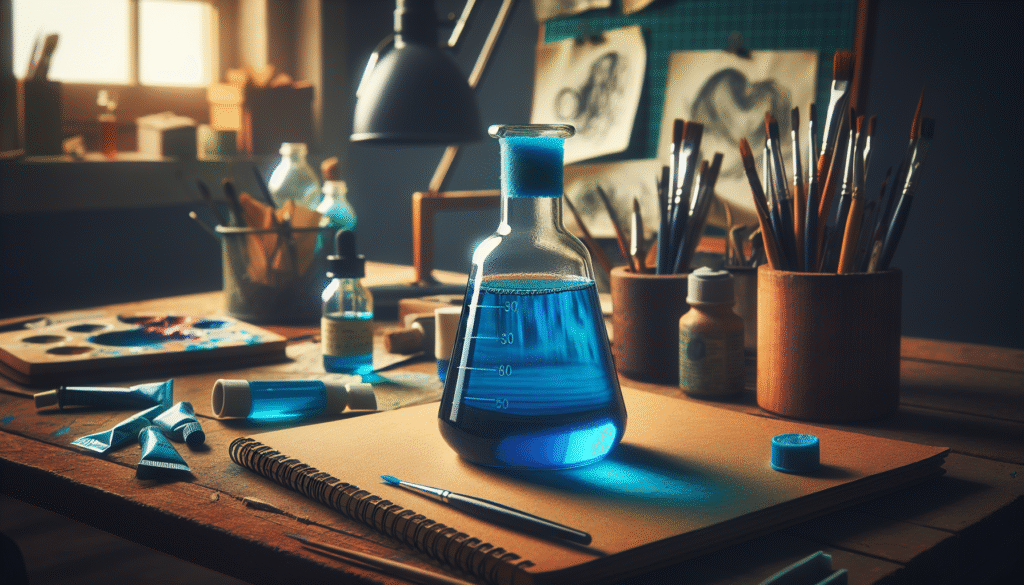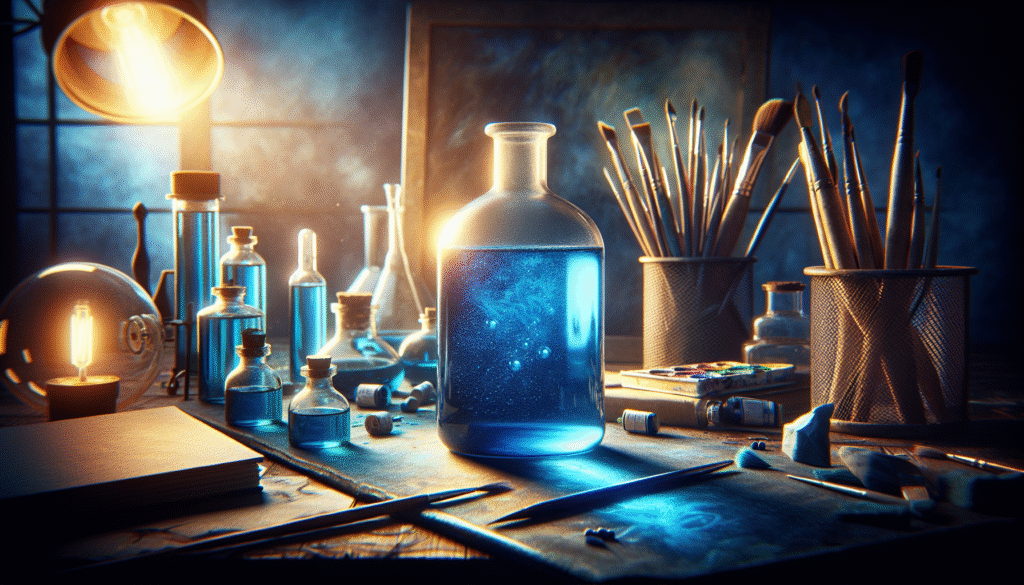
What if a simple dye could enhance your creativity and change the way you think? methylene blue, a chemical compound known primarily for its use in medicine and biology, is now being studied for its intriguing effects on cognitive functions, including creative thinking. This compound could hold significant potential for unlocking new ways of thinking and problem-solving.
Understanding Methylene Blue
Methylene blue (MB) is a synthetic dye originally developed in the late 19th century. Its applications range from serving as a biological stain to being utilized in the treatment of various medical conditions such as methemoglobinemia and even certain infections. While its primary uses are well-documented, burgeoning research suggests MB may play a more profound role in cognitive enhancement.
Chemical Composition and Properties
Methylene blue is a thiazine dye with the chemical formula C16H18ClN3S. Its distinctive blue color and unique chemical structure enable it to interact with various biological systems. The compound has a positively charged nitrogen atom, which allows it to bind to negatively charged biological molecules, influencing their function. Understanding its chemical properties is crucial for appreciating how it might affect cognitive functions, particularly creative thought.
Historical Context
Historically, methylene blue has been utilized for numerous medical applications. Its journey began in 1876 when it was first synthesized. Throughout the years, researchers noted its various properties, particularly its ability to penetrate cell membranes and influence mitochondrial function. These characteristics have sparked a new wave of interest in cognitive science, especially concerning its effects on the brain.
Methylene Blue and the Brain
The brain operates through intricate networks of neurons that communicate using electrical and chemical signals. Methylene blue’s action within this complex system is a focal point of ongoing research.
Mechanism of Action
Methylene blue is often described as a mitochondrial enhancer. The mitochondria, known as the powerhouses of the cell, play a crucial role in energy production. By improving mitochondrial function, methylene blue helps increase ATP (adenosine triphosphate) production, which is essential for various cognitive processes. Enhanced energy availability in neurons may lead to improved overall brain function, potentially heightening creative thinking.
Table 1: Mechanisms of Methylene Blue’s Action in the Brain
| Mechanism | Description |
|---|---|
| Mitochondrial Enhancement | Improves energy production in neurons |
| Antioxidant Properties | Reduces oxidative stress, protecting neural function |
| Neurotransmitter Modulation | Influences levels of dopamine and serotonin |
| Anti-inflammatory Effects | Mitigates neuroinflammation, promoting brain health |
Influence on Neurotransmitters
Neurotransmitters are crucial for communication between neurons. Methylene blue has been found to influence several neurotransmitter systems, primarily dopamine and serotonin. By enhancing dopamine levels, there exists the potential to bolster motivation and reward, key components in creative endeavors. Similarly, serotonin influences mood and cognition, which could contribute to a more conducive environment for creative thinking.

The Link Between Creativity and Cognitive Function
Understanding creativity is complex, as it intertwines cognitive processes such as memory, attention, and emotional regulation. Methylene blue’s effects on these cognitive functions may elucidate how it could potentially enhance creativity.
Cognitive Flexibility
Cognitive flexibility is the ability to adapt cognitive processing strategies to face new and unexpected conditions in the environment. Methylene blue may improve this flexibility by enhancing neural connectivity and communication. Enhanced cognitive flexibility permits individuals to break away from conventional thought patterns, allowing for innovative solutions and creative ideas.
Memory Enhancement
Memory plays a pivotal role in creativity. The ability to draw upon past experiences and knowledge is essential when generating new ideas. Methylene blue has been shown to enhance memory performance in various studies. Improved memory retention allows for a richer tapestry of experiences from which to draw, thereby fostering creativity.
Emotional Regulation
Emotional states significantly impact creative thinking. Negative emotions can stifle creativity, while positive emotions often lead to heightened creative output. Methylene blue’s potential effects on serotonin levels might serve to improve emotional regulation. By fostering a more positive mood, this compound can create the optimal environment for creativity to flourish.
Research on Methylene Blue and Creativity
While much of the existing research focuses on methylene blue’s application in clinical settings, recent studies have begun to probe its effects on cognition and creativity.
Animal Studies
Several animal studies have explored the cognitive enhancing properties of methylene blue. For instance, a study conducted on rats demonstrated that those administered methylene blue performed better on tasks measuring learning and memory than those who did not receive the compound. These findings suggest a potential role of methylene blue in enhancing cognitive performance, which could correlate with improved creative output.
Human Studies
Research involving human subjects is still nascent but promising. Recent trials have examined the effects of methylene blue on cognitive performance during tasks that require divergent thinking—a hallmark of creativity. Results indicated that participants who ingested methylene blue exhibited improved scores on creativity assessments, suggesting this compound may be capable of inducing a creative surge.
Table 2: Summary of Human Studies on Methylene Blue and Creativity
| Study | Population | Findings |
|---|---|---|
| Study A | Healthy adults | Improvement in divergent thinking scores |
| Study B | Older adults | Enhanced memory performance related to creativity |
| Study C | College students | Increased fluency in creative tasks |

Practical Implications
If the effects of methylene blue on creative thinking are substantiated, practical applications could extend far beyond experimental psychology.
Academic and Professional Settings
Students and professionals in creative fields might find methylene blue valuable as a cognitive enhancer. If permissible and supported by clinical findings, it could serve as a functional tool for enhancing creative problem-solving and innovation.
Artistic Endeavors
Artists and writers seek to tap into their creativity consistently. Methylene blue could offer a resource for increasing productivity and creative output, should the evidence support its use. However, ethical considerations and potential side effects must be carefully evaluated before widespread recommendations can be made.
Neuropsychological Conditions
Individuals with neuropsychological disorders that adversely affect creativity, such as depression or anxiety, may benefit from methylene blue’s mood-enhancing properties. Further research could lead to breakthroughs in treatment strategies aimed at improving creative avenues in therapy.
Safety and Considerations
While methylene blue presents intriguing possibilities, caution is warranted. Its usage should be approached with careful consideration of potential risks and side effects.
Potential Side Effects
The safety profile of methylene blue should be thoroughly understood. Common side effects include gastrointestinal disturbances, headaches, and skin reactions. In some cases, it can lead to more severe complications, particularly if used inappropriately or in excessive doses. Consulting with a healthcare professional before considering methylene blue is crucial.
Ethical Considerations
The ethical implications of using cognitive enhancers are profound. The pursuit of creativity through chemical enhancement raises questions regarding fairness, accessibility, and the essence of creativity itself. As you contemplate the use of methylene blue, consider how it aligns with your personal values and the broader implications for society.
Conclusion
Methylene blue is more than just a dye; it holds potential as a cognitive enhancer with the capacity to influence creative thinking. By understanding its mechanisms of action and the ongoing research surrounding its effects on cognition, you may find inspiration to harness its benefits responsibly. The intersection between chemistry and creativity opens a thrilling new horizon, inviting further exploration into how we can optimize our cognitive abilities.
By staying informed and navigating the landscape of cognitive enhancement thoughtfully, you can potentially unlock new avenues of creativity while remaining mindful of the complexities involved. The journey into this lesser-known territory is one that may redefine how you approach your creative process and the very fabric of innovation itself.